Cornelis de Bruijn
Cornelis de Bruijn (c.1652-1727) was a Dutch artist and traveler. He is best known for his drawings of the ruins of Persepolis, the first reliable pictures of these palaces to be accessible for western scholars. His other visits included the Ottoman Empire, Egypt, Jerusalem, Russia, and the East Indies.
Persia
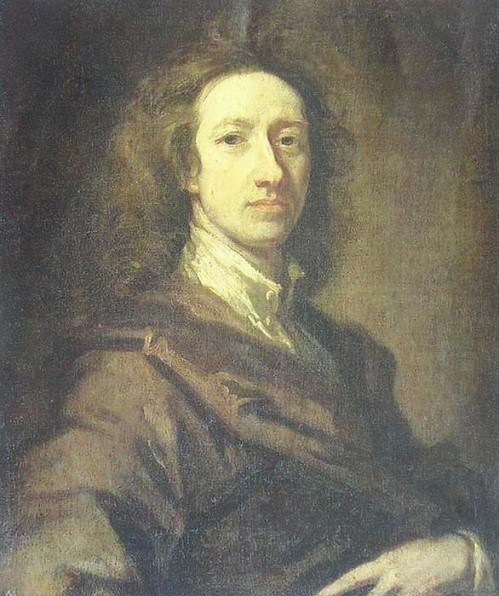
Persia was no longer what it once had been when Cornelis de Bruijn arrived in Derbent on 21 July 1703. For a century, it had been a superpower and had expanded its frontiers beyond the Caucasus, to the Aral Sea, and into Afghanistan. Its kings had favored the Shi'a Islam, but had been generally tolerant, and had done much to promote trade and develop agriculture. European merchants were well-known in the Iranian capital Isfahan. However, in 1694, shah Sultan Hussein had come to power, a deeply religious man who once allowed his palace to burn down as the fire was obviously the will of God. Even De Bruijn, who usually refrains from harsh criticism, mentions how the Persians complained about their king's unpractical attitude.
Sultan Hussein persecuted religious minorities - De Bruijn mentions how three Dutchmen converted to Islam - and was eventually forced to abdicate by an army of rebellious Afghanis (1722). So, during De Bruijn's visit, Persia was becoming unstable. For the first time in a century, the roads were no longer safe, and De Bruijn sometimes complains about it. In Shemakha, for example, he was forced to stay inside. On another occasion, he mentions how four Armenian travelers were killed in their sleep.
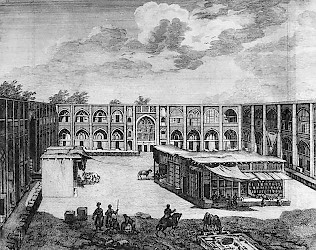
Still, even though he experienced a terrible dust storm, he could continue to Ardabil, crossed the Elburz Mountains, and reached Zanjan. After visits to the holy city of Qom (where he visited the mausoleum of Fatima and the tomb of shah Abbas the Great) and the ancient town of Kashan (where he saw the famous Fin gardens) De Bruijn finally reached Isfahan on 15 November. He was to stay for almost a year in Iran's beautiful capital, taking his residence in the house of an important official of the VOC,note François Kastelein. The painter and the merchant became close friends. De Bruijn also met Edward Owen, chief of the English East Indian Company, and was no stranger to the Armenian quarter of Isfahan. Visiting the Armenian quarter may have been a euphemism for visiting a prostitute, but De Bruijn had other motifs to visit this place - the Armenians had an excellent international network and cold offer him lots of useful information.
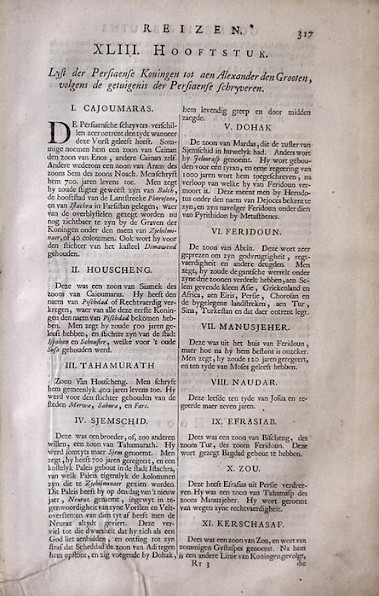
As usual, De Bruijn's pictures of Isfahan were splendid, and he carefully listened to the stories that people told him. One of the chapters if his Travels into Moscovy, Persia, and the East Indies deals with Persian history as the Persians themselves told it. It is, essentially, a very brief summary of the famous poem by Iran's national poet Firdausi, the Shahname, the "Epic of Kings", although stripped of its most mythological elements.
It was not the first attempt to explain Persian history, from a Persian point of view, to a European audience: in 1610, a Portuguese sailor named Pedro Teixeira had published a translation of the Tarikh-i rawzat al-safa ("History of the kings of Persia") by Mir Khvand, Muhammad ibn Khavandshah (1433-1498). This Portuguese book was to be translated into English by John Stevens in 1715.
De Bruijn's account also includes descriptions of Isfahan's famous shaking minarets, an arrival of the shah, and the Persian wine, which is favorably compared to French, Tuscan, and Cypriot wine. De Bruijn describes the sacred month Moharram, the Iranian New Year (No Ruz), and dedicates a full chapter to Ashura, in which the Shi'ites commemorate the tragedy of Kerbala, the historical fight in 680 in which imam Huseyn, a grandson of the prophet Muhammad, was killed.
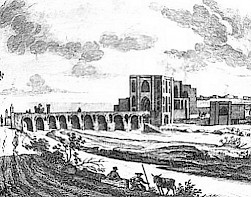
The description of Isfahan itself is typical for De Bruijn's method. After a big panorama of the city, he mentions the most important buildings, including the ones he was not allowed to visit. The interior of the Sheikh Lotfollah mosque, Isfahan's most lovely monument, is a square, he tells, "forty passes wide, as I asked someone to find out, because no one belonging to a Christian nation is allowed to enter". Probably, De Bruijn was told a convincing lie: Christians could even enter the mausoleum at Qom, and the real reason why he was not allowed to enter the Lotfollah mosque probably was that this was the place where the members of the royal family said their prayers.
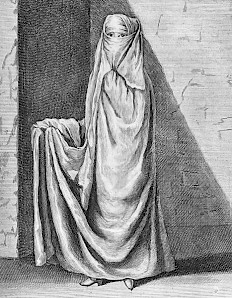
De Bruijn, who was fascinated by music, describes the Persian instruments, mentions the bridges of Isfahan, dedicates a chapter to the Persian government, describes how the Iranians dress themselves, and can of course not ignore the way in which the Persians paint. Iranian customs are mentioned and we learn about flora and fauna. De Bruijn tells about the Armenian quarter ("shameless women", he adds) and enumerates Christian religious orders. There's not a single aspect of topography, botany, zoology, or ethnography that he has left out.